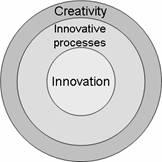“Creativity” as a word is often mistaken with “innovation” and vice versa, but between the two terms there are basic differences. According to a wide-spread idea creativity turns out to be a fundamental building block for innovation that can be defined as the implementation of creative ideas. For example Von Stamm (2003) asserts that:
| “If implementation is putting an idea into practice, creativity is coming up with the idea in the first place. Creativity is an essential part of innovation, is the point of departure.” |
In a similar way Gurteen (1998) defines creativity as “the generation of ideas” while innovation consists in transforming these ideas in action through a selection, an improvement and an implementation. Vicari (1998) has the same idea and asserts that creativity is the input while innovation the output.
The most common idea about the relationship between creativity and innovation derives from the opinion according to which internal business processes are very similar to external ones. As quite often industrial sectors are characterized by an innovative change which is the consequence of a technological change, thanks to a sort of “technology-innovation chain”, then we transpose the same succession inside firms and we imagine a sequence of events where creativity is the cause, while innovation is the effect. In other words creativity would be transformed into innovation; according to this idea, creativity is the input and innovation the output.
Then creativity would simply mean producing ideas, and innovation would be the result of a selection process which aims to divide the right ones from the wrong ones. Once we have selected working ideas, innovation would arise from their application. But this concept of innovation is not suitable for organizations.
We could say that creativity is not the source of innovative processes, it is not a sort of input for innovation; but it is the milieu, the environment where innovative processes are most likely to take place. Creativity is the context where innovation might develop. The graphical representation is the one which has been reported in the following figure.
Fig. 3.1 – Creativity and Innovation

In a system characterized by high levels of creativity there are several innovative processes, inside which innovation might flourish. Then innovation is the outcome, the result, while organizational creativity is the condition and we can say that a high level of creativity necessarily generates novelty.
A general draft of innovative process could be structured in four phases, as shown in the following figure:
Fig 3.2- The innovative process (Source: Mc Adam, McClelland, 2002)

Vicari (1998 ) analyzes the influence of creativity in management. In particular managers have to possess various abilities according to the level of complexity of environment and the level of competition of firm with competitors.
Tab. 3.1 - Types of management [adapted from Vicari,1998]
Competition |
Low |
Intuitive management |
Adaptable management |
| high |
Planned management |
Creative management |
|
This table allow to understand what kind of ability the management must have.
Survival of companies will depend on the ability to innovate and stimulate creativity. Creativity in a firm becomes the tool that allow to face the complexity of economic context and to go over the competitors.
| <--PREVIOUS | BACK TO TOP | INDEX | NEXT--> |